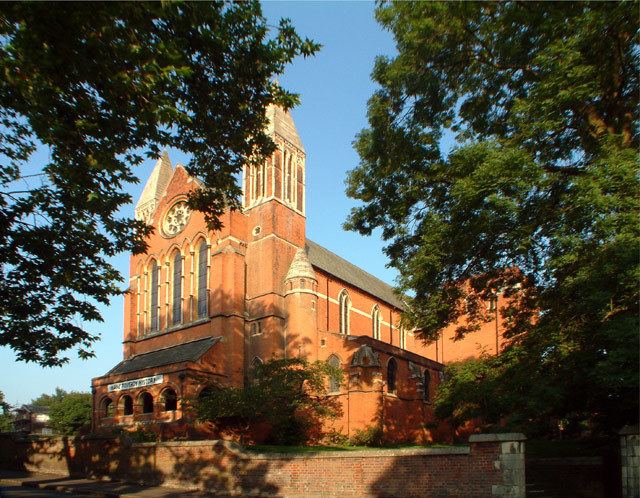Country United Kingdom Deanery Croydon North | Phone +44 20 8771 6686 | |
 | ||
Website www.stjohn-uppernorwood.org.uk Similar Wettern House, Architecture of Croydon, Altitude 25, Ruskin Square, Nestlé Tower Profiles | ||
St john the evangelist upper norwood fr john pritchard
The Church of St John the Evangelist is a Church of England church in Upper Norwood, a suburb of South London, in the United Kingdom. It is a Grade II* listed red brick Gothic Revival church which was built between 1878 and 1887 by the English architect John Loughborough Pearson (1817–97). The church is dedicated to the Christian saint, John the Evangelist.
Contents
History
In the 1870s, the London conurbation was steadily expanding into the rural county of Surrey and new suburban houses were built in the area of modern Upper Norwood, with dwellings ranging from houses for the more affluent businessmen to modest workers' housing being built over the former ancient Surrey woodland. A large, temporary iron church was built to provide a place of worship for the new area, which in October 1875 was moved to the site of the present church in Auckland Road. The Priests-in-charge were Rev Philip Kingswood and Rev Thomas Helmore.
Early in 1876 it became a parish church and the first vicar was Rev William Fairbairn La Trobe-Bateman, who began an initiative to clear the church's debts and raise funds to build a permanent church to replace the iron structure. The fundraising was supplemented by a memorial fund set up in memory of the vicar's wife, who died unexpectedly in 1878 from tuberculosis.
The parish engaged the services of John Loughborough Pearson, an eminent ecclesiastical architect who had already designed a number of churches in the Gothic Revival style which was at the height of fashion in Victorian Britain, including his most recent project in North London, the large-scale St Augustine's, Kilburn which he had completed in 1877. Pearson was to draw up plans for a building to seat 1000 people at Upper Norwood. The Foundation stone was laid on 6 May 1878 in a field, but building work could not commence until enough funds had been raised. The Church Commissioners contributed an additional £1000 on the condition that the building plans included a tower. In 1881, after a total of £7,156 pounds, 17 shillings and six-and-a-half pence had been raised, construction began; after six years of construction the building was consecrated on 30 April 1887. Church Commissioners' conditions were never met due to financial difficulty and the church to this day does not have a spire.
Among the previous incumbent priests have been Rev. Thomas Helmore (1873-1874), a noted authority on plainsong and English choral music; and Rev. Cecil Horsley, who was vicar from 1934 until 1938, when he was appointed Bishop of Colombo in the Church of Ceylon, later becoming Bishop of Gibraltar. John Taylor Smith, Bishop of Sierra Leone 1897–1901, had been curate at Upper Norwood 1885–1890. Rev Kenneth Mackenzie, who was Bishop of Brechin in the Scottish Episcopal Church from 1935–1943, served his curacy at St John the Evangelist 1903-05.
Architecture
Pearson's design is a plain red brick exterior with two turrets at the west end which Pevsner describes as "typically Pearsonian". The 160-foot (49 m)-long church is cruciform, and the south transept was originally designed to carry a 208-foot (63 m)-high tower, which was never completed. Above the nave is a tall clerestory.
The interior of the building is stock brick with arcades and brick rib vaulting. Most striking is the large stone rood screen across the chancel, which features five gothic arches topped by four statues, and the large carved stone reredos.
The church was damaged by the bombing during the Second World War and restoration work was carried out by the conservation architects Caroe & Partners between 1946 and 1951. The stained glass designed by Clayton & Bell was lost during the bombing, but a large rose window has survived which is the work of Ninian Comper, a renowned late Gothic Revival designer who lived in Upper Norwood on Beulah Hill.
The building is suffering from the effects of subsidence which has required the reconstruction of the rood screen and presently threatens the structure of the south aisle.
Music
Since the incumbency of Thomas Helmore, the Church of St John the Evangelist has maintained a strong tradition of music in Christian worship. The organ was originally built by Thomas Christopher Lewis in 1882 during the construction of the church, when only the chancel had been completed. The instrument was of an unusual design; while the organ itself was situated in the north transept, the console was placed on the other side of the church in the south choir aisle. This led to technical problems and the organ underwent several rebuilds in 1912, 1947 (following wartime bomb damage) and most recently in a restoration project undertaken in 1997-98 by Harrison & Harrison.
The church interior is noted for the quality of its acoustics and it is frequently used by classical music artists for CD recordings, including His Majesty's Sagbutts & Cornetts, Florilegium and I Fagiolini.
Location
The church is situated on the corner of Auckland Road and Sylvan Road, approximately 0.6 miles (0.97 km) to the south of Crystal Palace Park and 0.2 miles (0.32 km) north-east of the Croydon transmitter. The nearest railway stations are Crystal Palace and Anerley.
